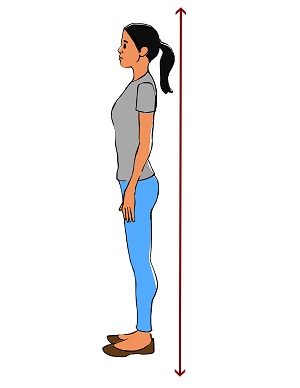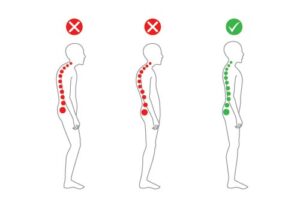

Ever caught a glimpse of yourself in a mirror and realized your neck is creeping forward like a vulture?
You’re not alone.
This posture problem, aptly named “vulture neck,” is more common than you think.
But don’t worry!
Fixing it doesn’t require a trip to the chiropractor or investing in fancy equipment. All you need are some simple standing techniques.
In this article, I will walk you through what vulture neck posture is, why it is problematic, and, most importantly, how to correct it with straightforward, effective standing exercises.
Contents of “How to Fix Vulture Neck Posture by Simple Standing Techniques” Article:
1) What Is Vulture Neck Posture?
2) The Consequences of Vulture Neck
3) The Science of Standing: Why Posture Matters
4) Simple Standing Techniques to Fix Vulture Neck
- Technique 1: The Wall Test
- Technique 2: Chin Tucks
- Technique 3: Shoulder Blade Squeeze
- Technique 4: Align Your Ears with Your Shoulders
5) How Long Does It Take to See Results?
6) FAQs on Standing Techniques for Fixing Vulture Neck Posture
7) Conclusion: Stand Tall and Beat Vulture Neck
What Is Vulture Neck Posture?
Vulture neck posture, also known as forward head posture (FHP), occurs when your head juts forward beyond its natural alignment with the spine.
Instead of your ears being directly over your shoulders, they’re positioned in front of them, creating that hunched, vulture-like appearance.
This misalignment can put extra strain on your neck and shoulders, leading to discomfort and even long-term health issues.
According to a study published in the Journal of Physical Therapy Science, forward head posture increases the load on the cervical spine by up to 30 pounds for every inch your head moves forward.
That is a lot of extra weight for your neck to carry!
The Consequences of Vulture Neck
So, why should you care about vulture neck?
Beyond the aesthetic concerns, this posture can have serious health implications. The most immediate consequence is neck and shoulder pain.
The misalignment causes muscles in your neck and upper back to work overtime to hold your head up, leading to muscle fatigue and discomfort.
But it does not stop there. Poor posture can also affect your breathing, as the forward head position compresses the ribcage and diaphragm, making it harder for your lungs to expand fully.
This can lead to shallow breathing, reduced oxygen intake, and even headaches.
Over time, untreated vulture neck posture can contribute to more severe conditions like cervical spine degeneration and chronic pain syndromes.
The Science of Standing: Why Posture Matters
Before we dive into the techniques, it is important to understand why proper standing posture is so crucial.
When you stand correctly, your body is in a natural alignment where your bones, muscles, and joints work efficiently together.
This not only minimizes strain on your body but also helps prevent injuries.
When you slouch or adopt a forward head posture, your body’s alignment is thrown off.
According to research published in the Journal of Orthopaedic & Sports Physical Therapy, poor posture leads to a cascade of musculoskeletal problems, including imbalances in muscle strength, joint wear and tear, and increased risk of injury.
Simple Standing Techniques to Fix Vulture Neck
Now that you know the risks of vulture neck, let me get to the good stuff—how to fix it!
Here are some simple, yet effective, standing techniques you can start using today.
Technique 1: The Wall Test
The Wall Test is a great way to check your posture and correct it in real-time.
Here is how you do it:
- Stand with your back against a wall, with your feet about 6 inches away from the baseboard.
- Press your lower back, shoulders, and head against the wall.
- There should be a slight gap between your lower back and the wall, just enough to slide your hand through.
- If your head isn’t touching the wall, gently tuck your chin and move your head back until it makes contact.
This position helps you become aware of what proper alignment feels like. The more you practice standing this way, the more natural it will become.
Technique 2: Chin Tucks
Chin tucks are a simple exercise that strengthens the muscles at the front of your neck, helping to pull your head back into alignment.
Here is how to do them:
- Stand or sit up straight, with your shoulders relaxed.
- Slowly tuck your chin towards your chest, creating a double chin. Make sure you’re not tilting your head down—this is a horizontal movement.
- Hold the tuck for 5-10 seconds, then relax.
Repeat this exercise 10 times, twice a day. Over time, this will help retrain your muscles to hold your head in a more neutral position.
>>> Want to Learn How I Fixed My “Vulture Neck Posture” at Home??? Click Here to Find Out! <<<
Technique 3: Shoulder Blade Squeeze
Your shoulders play a significant role in your posture. Strengthening the muscles between your shoulder blades can help you maintain a better standing posture.
Here is how to perform the shoulder blade squeeze:
- Stand up straight with your arms by your sides.
- Gently squeeze your shoulder blades together, imagining that you’re trying to hold a pencil between them.
- Hold the squeeze for 5-10 seconds, then relax.
Do this exercise 10 times, twice a day. It will help open up your chest and bring your shoulders back, counteracting the forward head posture.
Technique 4: Align Your Ears with Your Shoulders
This technique is simple but effective for maintaining good posture throughout the day. It’s all about being mindful of your head position relative to your shoulders.
Here is how:
- Stand up straight with your shoulders back and down.
- Imagine a string pulling your head up towards the ceiling.
- Gently move your head back until your ears are aligned with your shoulders.
Check in with your posture throughout the day, especially if you spend long hours sitting or looking at a screen. Making this small adjustment can go a long way in correcting vulture neck posture.
How Long Does It Take to See Results?
Fixing forward head posture is not an overnight miracle, but it’s also not a lifelong struggle.
Let’s break it down.
Immediate Benefits (A Few Days)
The first thing you shall notice after starting exercises for forward head posture is some relief from tension headaches and neck stiffness.
This happens because your muscles, especially the sternocleidomastoid and upper trapezius, are getting stretched and reactivated.
According to a study in the Journal of Physical Therapy Science, even a single session of postural correction can improve cervical spine alignment and reduce strain.
Notable Postural Improvements (4-6 Weeks)
Your body adapts surprisingly fast—if you’re consistent. Within a month, you should see your head naturally sitting more in line with your shoulders instead of jutting forward.
Research from Clinical Biomechanics found that daily postural exercises (such as shoulder stretches or chest stretch) combined with ergonomic changes can significantly improve head positioning within 4-6 weeks.
Long-Term Correction (3-6 Months)
For permanent changes, muscle memory needs to kick in. Strengthening the deep cervical flexors (the small but mighty stabilizers in your neck) and stretching tight chest muscles takes time.
According to a Harvard Medical School report, habits—especially postural ones—take at least 66 days to become second nature.
Beyond 6 Months: A New Normal
If you continue doing chin tucks, scapular retractions, and pec stretches, your forward head posture will become a thing of the past.
The key? Consistency.
Slouching all day and expecting 10 minutes of stretching to fix it won’t cut it.
Pro Tips to Speed Up Results:
✅ Do posture checks throughout the day
✅ Set up an ergonomic workspace (monitor at eye level, supportive chair)
✅ Combine exercises with massage therapy or chiropractic care
✅ Move frequently—sitting too long reinforces poor posture
Bottom line: Most people see noticeable improvements within a month, but for lasting correction, 3-6 months of consistency is the golden rule. Your neck (and future self) will thank you!
FAQs on Standing Techniques for Fixing Vulture Neck Posture
Q-1: What’s the quickest standing check to counter “vulture neck” with no equipment?
A-1: Stand hip-width, knees soft, and stack ears over shoulders over hips over ankles. Let your eyes—not your head—gaze ~15–20° downward so your chin doesn’t jut. Imagine a string lifting the crown of your head and a light weight in each back pocket to settle your shoulder blades. Breathe low into the ribs for three slow breaths. This resets head position without stiffening your lower back.
Q-2: How do I use a 30-second “chin-tuck + scapula set” to re-align while standing?
A-2: Draw your chin straight back (no nodding) as if making a double chin; hold for a slow 3-count inhale and 3-count exhale. Then glide shoulder blades down and slightly in—not a shrug, not a squeeze. Do three breath cycles. This pairs deep-neck-flexor activation with scapular stability so your head sits over your trunk instead of hanging in front of it.
Q-3: What stance details stop my head from creeping forward again after I “fix” it?
A-3: Build a stable base: feet under hips, toes turned out a touch, weight evenly spread heel-to-forefoot. Unlock your knees and “stack ribs over pelvis”—no rib flare, no glutes clenching. When the base is balanced, your body doesn’t drag the head forward for balance. If you catch yourself bracing your low back, exhale and soften the ribs; your neck will follow.
Q-4: Is there a fast wall drill to open the chest and ease neck strain while standing?
A-4: Try Wall Angels. Stand with back to a wall, back of head touching comfortably, ribs “heavy.” Place forearms on the wall and slide them up 10–15 cm, then down, keeping a light chin tuck. Do 6–8 slow reps. You’ll blend gentle thoracic extension with scapular control, which reduces upper-trap overwork and helps maintain a taller head position afterward.
Q-5: How often should I “micro-reset” during long standing tasks?
A-5: Every 20–30 minutes, run a micro-sequence: chin-tuck (one breath), scapula set (one breath), shake out arms, re-stack (one breath). If tension lingers, add 30–60 seconds of walking or calf/pec stretches. Frequent small resets beat occasional long sessions because they keep tissues from stiffening and remind your nervous system of the neutral head-over-torso position.
Takeaway: Stand on a solid base, align with a gentle chin-tuck and scapula set, and sprinkle micro-resets through the day. These simple standing techniques steadily retrain head-neck position without special gear.
Stand Tall and Beat Vulture Neck
Vulture neck posture may be a common issue, but it’s far from insurmountable.
By incorporating these simple standing techniques into your daily routine, you can correct your posture, reduce discomfort, and prevent long-term health issues.
Remember, the key is consistency. The more you practice proper standing posture, the easier it will be to maintain it naturally.
So, in order to to learn how to fix forward head posture fast, simply stand tall, keep your head aligned, and say goodbye to vulture neck for good!
References:


